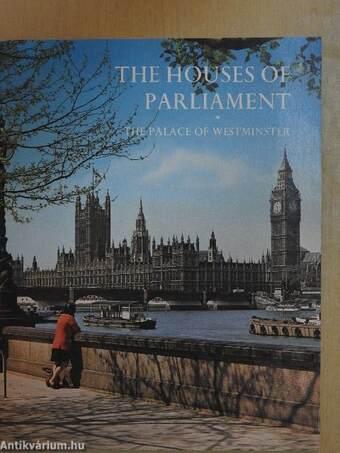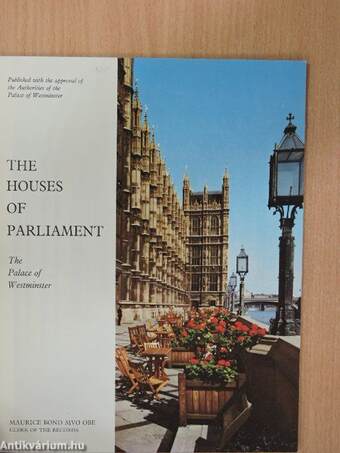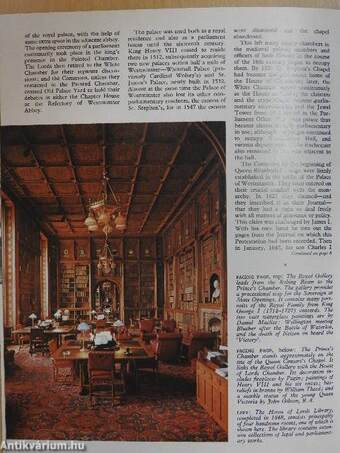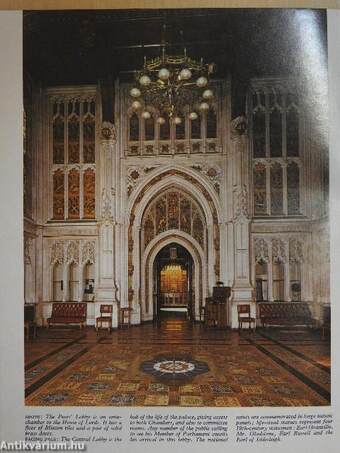1.062.463
kiadvánnyal nyújtjuk Magyarország legnagyobb antikvár könyv-kínálatát

VISSZA
A TETEJÉRE
JAVASLATOKÉszre-
vételek
The Houses of Parliament
The Palace of Westminster
| Kiadó: | Pitkin Pictorials Ltd. |
|---|---|
| Kiadás helye: | London |
| Kiadás éve: | |
| Kötés típusa: | Tűzött kötés |
| Oldalszám: | 24 oldal |
| Sorozatcím: | Pitkin Pride of Britain Books and Colour Souvenirs |
| Kötetszám: | |
| Nyelv: | Angol |
| Méret: | 23 cm x 18 cm |
| ISBN: | 85372-008-8 |
| Megjegyzés: | Színes fotókkal. |
naponta értesítjük a beérkező friss
kiadványokról
naponta értesítjük a beérkező friss
kiadványokról
Előszó
The History of THE PALACE OF WESTMINSTER THE name 'Westminster' means the minster (or monastery) established to the west of the city of London. This monastery was the ancestor of the present... TovábbElőszó
The History of THE PALACE OF WESTMINSTER THE name 'Westminster' means the minster (or monastery) established to the west of the city of London. This monastery was the ancestor of the present Westminster Abbey. It remained small and somewhat isolated until, in the years between 1050 and 1065, King Edward the Confessor enriched and re-founded it. Then, between the new monastery and the bank of the River Thames he constructed a home for himself; this residence was the first Palace of Westminster. Both the Confessor's monastery and his palace were sufficiently near completion in 1066 to enable his Norman successor, William the Conqueror, to be crowned in the abbey church, and subsequently to hold Court in the palace. Soon after the Norman Conquest the palace received a notable addition: a Great Hall was built by King William II at its northern end. This hall (unlike Edward the Confessor's palace itself) still stands today after 900 years' continuous use. When it was built, Westminster Hall, somé 240 feet long and 67 feet wide, was perhaps the largest hall in Europe. It was, indeed, sufficiently impressive to make Westminster the ceremóniái centre of the kingdom as well as one of the principal homes of the English monarchs, and in due course to attract to its neighbourhood much of the governmental system of the country. On its completion in 1099 the hall had a simple wooden roof, supported on two lines of posts down either side. above, right: The Jewel Tower is one of the oldest surviving parts of the Palace of Westminster. It was built in 1365 to house the jewels and other personal belongings of the king. The tower is open to the public daily, free of charge. facing page: The Royal Staircase leads up to the principal floor of the palace. A t the State Opening it is lined by Household Cavalry as The Queen ascends escorted by the Great Officers of State. Three centuries later, between 1394 and 1399, King Richárd II removed these posts and substituted for the originál roof the present superb hammer-beam roof, one of the finest pieces of wood-carving in the country. The hall was further adorned by a series of full-sized statues of kings. Eleven of these are still to be seen in niches at the south end and in window embrasures along the east wall. Although royal Councils had sometimes been held in Westminster Hall, Parliament never met regularly there. The hall served principally as the meeting place of the King's Courts of Law. From the 14th to the 19th centuries the Court of Chancery sat against the south wall of the west side, King's Bench against the south wall on the east side, Common Pleas near the middle of the west wall (though until 1740 only), and the Court of Exchequer in an adjacent room to the north-west. The remaining space within the hall along the walls was occupied by shops and stalls, and the whole interior was open to the public. Westminster Hall thus became one of the chief centres of London Iife, both a spectacle and a meeting place. The domestic part of the medieval palace lay to the east and south of Westminster Hall. The kings worshipped in St. Stephen's Chapel, their courtiers in the crypt chapel beneath; the canons who served the two chapels worked in the adjacent cloisters. The royal family dined in the lesser hall (roughly on the site now occupied by Richárd I's statue), and after dinner the king would withdraw to his main priváté apartment, the Painted Chamber, and the queen to her own royal VisszaTémakörök
- Idegennyelv > Idegennyelvű könyvek > Angol > Művészetek > Építészet
- Idegennyelv > Idegennyelvű könyvek > Angol > Művelődéstörténet
- Idegennyelv > Idegennyelvű könyvek > Angol > Helytörténet
- Művelődéstörténet > Kultúra > Története
- Helytörténet > Külföldi > Városok
- Helytörténet > Helyismeret > Várak, építmények
- Művészetek > Építészet > Kontinensek szerint > Európa > Angol
- Művészetek > Építészet > Idegen nyelv > Angol
- Művészetek > Építészet > Műemlékek > Középületek > Államigazgatás
- Művészetek > Építészet > Műemlékek > Kastélyok
Megvásárolható példányok
Nincs megvásárolható példány
A könyv összes megrendelhető példánya elfogyott. Ha kívánja, előjegyezheti a könyvet, és amint a könyv egy újabb példánya elérhető lesz, értesítjük.









